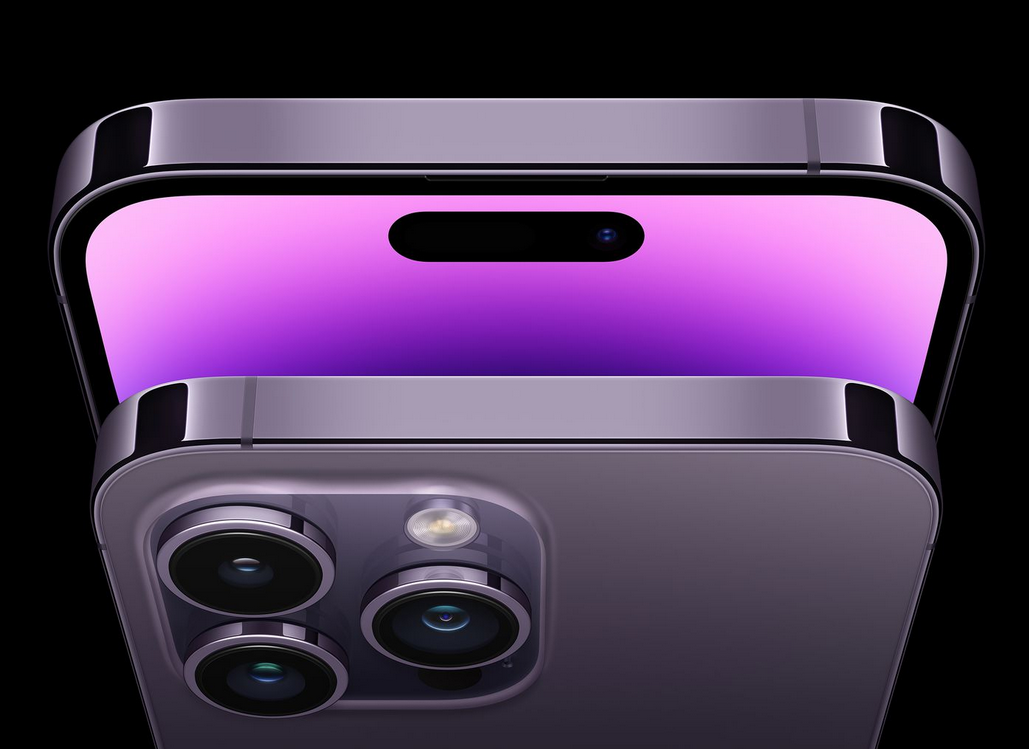In recent years, Apple has made the top bezel of its iPhone devices smaller and less obtrusive. The company has done this by making the notch—a small rectangular cutout in the phone’s display—larger than the Face ID components and selfie camera that it houses. With the new models of iPhone 14 Pro and iPhone 14 Pro Max, however, Apple has reduced the size of the notch and given it more functionality. Now called Dynamic Island, this area can alter its appearance based on a number of factors, including whether you’re using your phone’s camera or browsing apps like Safari or Instagram.
The 14 Pro and Pro Max are the same sizes as before (i.e., 6.1 and 6.7 inches, respectively) but they now feature an upgraded display, a new processor, significantly improved cameras, and several completely new features that may actually help save your life.
About that island
The Dynamic Island is a new feature in iOS 14. When apps perform certain actions, they show up in the Dynamic Island. The shape of the island changes as each app does something different. If you play music in Apple Music and then minimize it, the app will get swallowed by the Dynamic Island. The island will then show a tiny icon with album artwork and an animated music visualization. If you then start a timer, it will be added to the Dynamic Island—which will split into two separate bubbles, each a miniature version of the corresponding app. Touch any of those bubbles, and it’ll launch the appropriate app; touch and hold a bubble, and the island will grow larger, giving you a quick overview of what the app is doing.
The Dynamic Island is a small black bar at the top of the screen that serves as a cover for the selfie camera and Face ID sensors. It only appears when an app is active in the background or when your phone wants to notify you of something, such as an incoming call or Face ID unlock. This works for all apps that ping Apple’s NowPlaying or CallKit API, and cannot be disabled or customized. Apple has integrated the Dynamic Island into the phone’s other functions well. It looks cool, is pretty intuitive, and — most importantly — makes you completely forget that the Dynamic Island is there to hide the selfie camera and Face ID components. It becomes a new feature, something that brings new functionality and is thus almost desirable, instead of being something you’d want to get rid of. It’s never in the way — flip the phone horizontally to watch a video and the Dynamic Island stops being anything other than a small, black cutout.
The Dynamic Island works with any iOS app, not just Apple apps. I tried it out with Spotify and WhatsApp, and the experience was similar to how it is with Apple Music and phone calls. With third-party app support baked in from the start, developers are likely to flock to take advantage of the new functionality, making the Dynamic Island more…well, dynamic over time. Live Activities, an iOS 16 feature that lets you put widgets on your home screen, will be available later this year and it too will work with the Dynamic Island. I do have concerns about the Dynamic Island, though. Being on top of the phone and hard to reach with one hand (especially on a 6.7-inch iPhone 14 Pro Max), it’s easy to cover up when using one-handed. Also, touching that area will leave smudges all over your front camera lens. And though fun at first use, it often goes unused after a few days as people forget about it when not in use like before.
In any case, I need to compliment Apple for having a go at a novel, new thing here. Basically, all cutting edge cell phones have some kind of score or poke hole pattern for their front cameras, and, as of recently, none of the cell phone producers remembered to transform that region into an intuitive component.
Continuously on, yet no doubt
The Powerful Island isn’t the main enormous change to the iPhone 14 Master and Ace Max’s presentation. Interestingly, Apple has presented a consistently on highlight, implying that the presentation doesn’t simply shut down when it nods off.
Android telephones, similar to the World S22, have had consistently on shows for a long time currently, yet Apple’s execution is somewhat more remarkable. Rather than decreasing the showcase to a more modest, worked on variant with essential data (i.e., time, date, and climate) and notices, Apple is providing clients with a full however dimmer perspective on their home screen. Your backdrop, time, date, as well as your gadgets as a whole and as of now running applications, for example, Music, will stay noticeable when the telephone nods off. The showcase won’t be enlivened in this state, yet it will remain dynamic. For instance, assuming you have music playing and the tune changes, this will be apparent in any event, when the showcase is “snoozing.”
Apple has made this conceivable with new screen tech that can decrease the invigorate rate to only 1Hz (down from the most extreme revive pace of 120Hz). The presentation likewise switches off completely when you put the telephone down all over or move far away from it (while wearing an associated Apple Watch). This is all set up so that the consistently on include consumes less battery duration. I haven’t had sufficient opportunity to appropriately test this, however it didn’t seem like the battery duration was fundamentally more regrettable with the consistently in plain view empowered than without it.
All things considered, I’m not especially enamored with the consistently in plain view. Having the presentation continually on feels nosy in an odd manner. I’m utilized to the telephone screen being dark when I put it down on the table and I don’t know I want it to show me something constantly. Apple’s own Center modes are there to ensure you don’t invest undesirable energy with your telephone and a showcase that is dependably on feels practically illogical. Nonetheless, the component is effectively switched off in the iPhone’s settings, so it’s difficult to blame Apple for including it. On the off chance that you could do without it, switch it off.
The presentation of the iPhone 14 Ace and 14 Ace Max is currently likewise more brilliant than previously, as it can accomplish a greatest “top” splendor of 2,000 nits (that is twofold the maximum brilliance of the iPhone 13 Ace). I’ve tried the new iPhones against my old iPhone 13 Expert in the brilliant sun and the 14 Genius was discernibly more splendid. However, the thing that matters was exclusively there when I had white letters on a dark foundation (another motivation to change to Dull Mode).
Party toward the front, business toward the back
The Powerful Island and the consistently in plain view highlights make the new iPhone 14 Expert models in a split second conspicuous from the front, which is significant for individuals who like their new cell phone to look new when contrasted with last year’s rendition (peruser, I’m one of these individuals).
On the back, the most recognizable change will be the new tones: profound purple, space dark, gold, and white. They’re all new — the gold is somewhat more yellow and the white is more white than the magnificent white of days gone by. The dark variant has a genuinely ebony hardened steel outline and a dim back, and I sense it very well may be a number one for some clients. The profound purple is great, yet feels excessively curbed, particularly in low light. I’d in any case go for the profound purple, yet know it’s not the flashiest of varieties.
Other than that, the new models are generally equivalent to last year’s iPhones. They come in two sizes — 6.1 and 6.7 inches — and have an earthenware safeguard on the front and a hardened steel outline.
I say “generally” in light of the fact that there are unpretentious contrasts. The iPhone 14 Ace is 0.2mm thicker and 0.8mm longer than its ancestor. The camera focal points are a hair bigger than previously, similar to the whole camera knock, however you’ll just notification this with an estimating tape. Awful news: I’ve taken a stab at stuffing the iPhone 14 Genius into Apple’s true silicone case for the iPhone 13 Star, and it didn’t fit. Time to hack up another $49 (or something else) for another case.
Imperceptible power
Not at all like the ordinary iPhone 14 models, the Star variations accompany Apple’s new A16 Bionic chip. There’s not a lot to report here as far as client experience, as you will not actually notice the speed enhancements.
Indeed, the iPhone 14 Master and Expert Max feel incredibly smart, however last year’s models are similarly as quick. The battery duration, while ostensibly improved, is generally something similar: One and a half days for the iPhone 14 Star Max during customary (yet weighty) utilization. On the iPhone 14 Ace, which I invested less energy with, I got around a day of purpose.
Main concern is that Apple’s cell phone chips are so in front of all the other things that you just beginning seeing log jams following a couple of long stretches of purpose. For instance, my GeekBench computer chip score on the iPhone 14 Genius Max was 1,869 for the single-center and 5,461 for the multi-center score, which helpfully beats all Android gadgets. It’s good to have the most recent chip, yet it’s not exactly fundamental.
Life-saving features
All apple’s new iPhone 14 models accompany two elements that are unconventional essentially in light of the fact that you will not at any point hope to utilize them, yet you’ll be cheerful they’re there.
One is Crash Location, which utilizes the iPhone’s different sensors to recognize whether you’ve been in a fender bender and, provided that this is true, it allows you to dial 911 or can consequently do it for you in the event that you’re debilitated.
Clearly, I want to believe that I never get to test it, yet it’s a decent element to have and something that individuals with kids who are mature enough to drive will probably consider while getting them another telephone. Something cool about this one is that it’s accessible around the world.
The other is Crisis SOS, which is intriguing both for viable angles and the tech development made it conceivable. It permits you to send a crisis message when there are no phone towers around and you have positively no gathering. You do this by going through a short arrangement process with inquiries concerning the idea of your crisis and afterward guiding the telephone towards the sky toward see as a satellite.
After the iPhone send off occasion in Cupertino, Apple set up a test close to Apple Park for me to attempt this and it functioned admirably, just requiring a couple of moments for me to secure the satellite and send the SOS. The test was set up underneath parasols, which didn’t create some issues with gathering by any stretch of the imagination, implying that light foliage above you would most likely likewise be fine.
Obviously, radiating a sign to a satellite from a gulch will be intense. Utilizing a telephone when seriously harmed would presumably be intense too. Be that as it may, it’s not great, but not terrible either than nothing when you lose all sense of direction in the wild without water, for instance. The component additionally permits you to radiate your area to companions or family, which is perfect for mountain climbers and individuals who like to camp or climb in the wild.
It was cool to have the option to convey to a satellite with a standard telephone, with no requirement for a unique recieving wire. The extent of utilization might be limited at this moment, however it opens up the opportunities for different highlights, like involving satellites for sending real messages to companions from here on out.
Final Words
The iPhone 14 line has many new elements and changes you won’t see right away. For instance, the Star models presently have double surrounding light sensors — one on the front, and one on the back — which ought to additionally further develop how the telephone’s presentation acts in different kinds of light. I took the 14 Ace and the 13 Master in my grasp, held them against splendid light, and afterward dismissed and went into a dim room, and the 14 Genius was more responsive in adjusting the presentation’s splendor.
The whirligig and accelerometer sensors in the telephones were likewise redesigned, which ought to assist with the Accident Recognition highlight, however could likewise be valuable in alternate ways which I haven’t found at this point.
The showcase goal on the 14 Star and the 14 Expert Max was marginally expanded, as well, yet it’s basically impossible that you’ll differentiate. The iPhone 13 Star has a 2,532 x 1,170 pixel goal, while the 14 Ace has a 2,556 x 1,179 pixel goal. The Star Max has a comparative expansion in pixels, as well. Likewise, the 14 Expert is two grams heavier than the old model.



